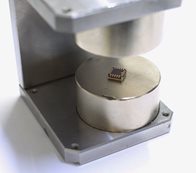The unique properties of graphene mean that it will have a huge impact on electronics. One example is in semiconductors, where the thinness and conductivity of graphene give it the potential to replace existing technology for computer chips.
One of Paragraf’s technologies is graphene-based Hall sensors, which measure fluctuations in magnetic fields. Sensors like these are common in cars where they measure current by sensing fluctuations in magnetic fields, but Paragraf are the only company whose product is a graphene-based electronic device.
Paragraf approached NPL to investigate how these sensors performed in extreme environments, including at high temperatures, at high frequencies and when exposed to radiation. By investigating the impact of extreme conditions on its product, Paragraf hoped to reveal new applications in new markets, significantly enhancing its commercial potential.
 NPL performed three sets of investigative tests on Paragraf sensors. Temperature and humidity testing using conditions seen in a typical battery enabled Paragraf to modify the sensors to open a new application in car batteries. The new design can now be used to monitor small changes in current, which represent small failures in the battery and there is no other available product that can be applied in this way.
NPL performed three sets of investigative tests on Paragraf sensors. Temperature and humidity testing using conditions seen in a typical battery enabled Paragraf to modify the sensors to open a new application in car batteries. The new design can now be used to monitor small changes in current, which represent small failures in the battery and there is no other available product that can be applied in this way.
The sensors performed well at high frequency testing which opened up applications in power electronics. Specifically, the sensor can be used in aeroplane turbines, where it monitors the magnetic field associated with current fluctuations. This precise sensing enables manufacturers to measure the input current more accurately, and therefore implement more efficient power use, making a significant difference in terms of environmental impact.
Radiation testing showed that the sensors performed well when exposed to high levels of gamma and neutron radiation. This revealed that expensive radiation protection is not required, for the operation of Paragraf’s device and opened up a host of new applications in space technology, such as in satellites and other machinery operating in space.
Paragraf’s sensors can now be incorporated into the batteries of electric vehicles. Early detection of failures helps make the vehicles more sustainable and safer, as well as supporting the decarbonisation of transport. For this purpose, other sensors are either too large or insufficiently accurate, so Paragraf’s sensors are the only option for detecting failures in these batteries.
NPL’s experience with graphene standards and expertise in testing was invaluable to the project giving an insight into internal re-configuration that led to the electric vehicle battery application, and revealing new applications for the sensors in turbines and space technologies.
These new applications have allowed Paragraf to commercialise its product for the automotive and space sectors, considerably enhancing its commercial offering.
NPL’s experience in graphene standards and characterisation, as well as their unique testing capabilities made them the best choice to work with our graphene electronic devices and help us identify the best applications. The results have been extremely valuable, opening up entirely new applications for our devices, and enabling us to enter new markets, where we are already having exciting conversations with customers about how our devices can be used
Ivor Guiney, Technical Director - Paragraf
 Based near Cambridge, U.K, Paragraf is a spin-out from the Department of Materials Science at Cambridge University. At its custom R&D and production facility it produces the highest-quality large-area graphene and develops step-change graphene-based electronic devices utilising its expertise in thin film materials production, solid state structure and device processing, and novel material product application.
Based near Cambridge, U.K, Paragraf is a spin-out from the Department of Materials Science at Cambridge University. At its custom R&D and production facility it produces the highest-quality large-area graphene and develops step-change graphene-based electronic devices utilising its expertise in thin film materials production, solid state structure and device processing, and novel material product application.